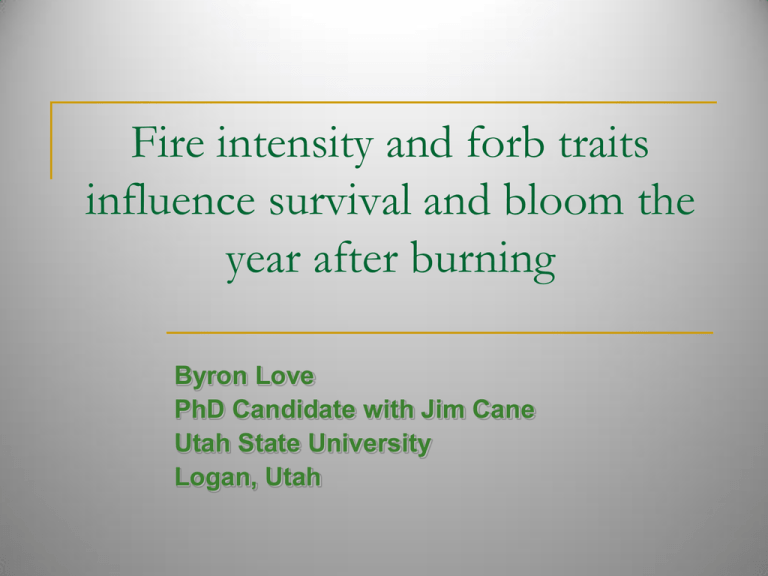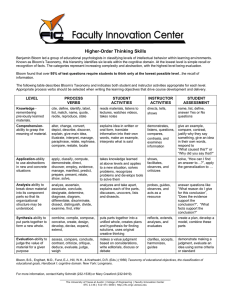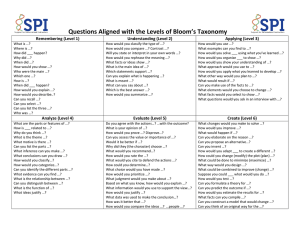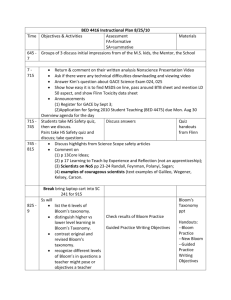Fire intensity and forb traits influence survival and bloom the
advertisement

Fire intensity and forb traits influence survival and bloom the year after burning Byron Love PhD Candidate with Jim Cane Utah State University Logan, Utah Bees Survive Fire Adults continue nesting Immatures emerge next year Post fire bloom needed to retain bee fauna Post fire flush of wildflowers Fact or fiction? Literature relevant to firesurviving bees is sparse - population & community response - richness, abundance & cover measures - grasses do no provide usable pollen & nectar Vegetation recovery from a surviving bee’s perspective: Must focus on the first year post-fire in order to retain bee fauna Study Requirements: -First year post-fire -Forb-centric (bee plants) -Correct age (mature) -Good health (bloom & phenology) Perennial forbs important for Great Basin bees Eriogonum umbellatum, Sulphur buckwheat Penstemon cyaneus, Blue penstemon Astragalus filipes, Basalt milkvetch Species Growth Form Bee Fauna Fire Tolerance Astragalus fillipes Forb/herb Generalist Medium Dalea ornata Forb/herb Generalist Unknown Eriogonum umbellatum Low-growing Woody Meh Low Lomatium dissectum Forb/herb; Taproot Specialist High Penstemon cyaneus Subshrub; Forb/herb Generalist Specialist Unknown Sphaeralcea grossulariifolia Rhizomatous; Deep woody taproot Specialist Medium Dalea ornata, Western prairie clover Lomatium dissectum, Fernleaf biscuitroot Sphaeralcea grossulariifolia, Globe mallow Photo Credit Clint Shock Study Design Option #1 (Natural Setting) Study Design Option #1 (Natural Setting) Pros Cons -Serious adrenaline rush -Kinda dangerous -Probably illegal -No control of: -Fire intensity -Soil type/nutrients -Water availability -Age Class -Weed/Pest Pressure Study Design Option #2 (Agricultural Setting) Malheur Experiment Station -Still kinda dangerous -Control of: -Fire intensity -Soil type/nutrients -Water availability -Age Class -Weed/Pest Pressure The Art of Artificial Burns Wright, Bunting & Neuenschwander, 1976. Effect of Fire on Honey Mesquite DeBano et al., 1979. Soil Heating in Chaparral Fires 700 Surface Temps Temperature (°C) 600 500 400 300 200 100 0 Minutes 15:00 14:00 13:00 12:00 129 + 15 11:00 629 + 53 0 10:00 102 + 23 20 09:00 500 + 78 40 08:00 66 + 6 07:00 353 + 31 60 06:00 57 + 4 80 05:00 Very High 241 + 60 100 04:00 High 49 + 4 03:00 Medium 132 + 37 -2 cm Temps 120 02:00 Low -2 cm 00:00 Very Low 7.5 psi, 24 sec 7.5 psi, 50 sec 15 psi, 65 sec 15 psi, 175 sec 15 psi, 240 sec Surface 140 Temperature (°C) Burn Prescription Treatment 01:00 Temp + sd Burn Treatments - 6 Perennial forb species - 6 Burn treatments (control to scorch) - 4 Replicates - 14 to 72 plants per replicate (2 to 15 plants per trial) - 144 Trials - August, 2012 (fire season) Post Burn Data Collection, Spring & Summer, 2013 Species Mortality Inflorescence Production Bloom Production and Timing Astragalus fillipes X X Bloom Presence / Absence; Pod Qty (bloom surrogate) Dalea ornata X X Bloom Phenology; Inflorecscence length (bloom surrogate) Eriogonum umbellatum X X - Lomatium dissectum X X - Penstemon cyaneus X X - Sphaeralcea grossulariifolia X - - 70 Fire Hardy Forbs 60 % Mortality 50 40 ASFI 30 DAOR LODI 20 10 0 Control Very Low 100 90 Low Medium Burn Treatment High Very High Fire Susceptable Forbs 80 % Mortality 70 60 50 ERUM 40 PECY 30 SPGR 20 10 0 Control Very Low Low Medium Burn Treatment High Very High Effect of Fire Severity on Bloom Astragalus filipes 100 % in bloom 80 60 40 20 0 Inflorescences 12 Penstemon cyaneus 9 6 * 3 0 120 Dalea ornata Inflorescences 100 80 60 40 20 0 * * Results Summary Fire Tolerant Inflorescence Reduction Reliable Bloom Bloom Suppression Phenology Shift Astragalus fillipes Yes No Yes No - Dalea ornata Yes No Yes Low Severity Fires No Eriogonum umbellatum No Yes No - - Lomatium dissectum Yes No Yes No - Penstemon cyaneus No Yes No - - Medium - - - - Species Sphaeralcea grossulariifolia Conclusions Reseeding choices in fire prone habitats (e.g., E. umbellatum vs. A. filipes ) Bee fauna persistence likely on firetolerant species (offers buffer for planting of slow-growing species) Better interpretation of origin of bigger plants in 2-5 year old burns (survivors, not recruits) What are the effects of repeated burning on mortality and bloom suppression? Field Examples Acknowledgements: Jim Cane, USDA ARS Bee Lab USFS & BLM Clint Shock, Malheur Experiment Station Scott Jensen, Provo Shrub Lab and of course... Nancy Shaw





